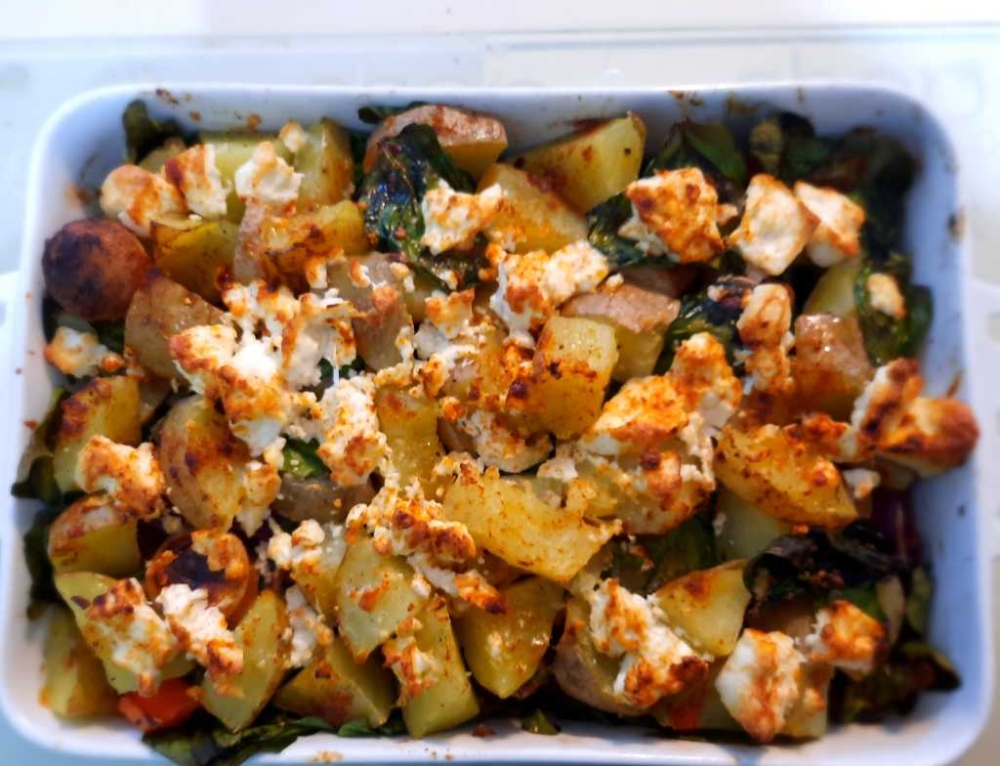Next time you wince at the thought of paying $4 for a bunch of basil, knowing you’ll probably only use a quarter of it, take heart … if you follow the advice below, it could be the last time you ever have to cough up for it. Or spring onions, or lemongrass, or any number of other fruit, veggies or herbs.
Forget about buying seeds … all you need are the veggie scraps that you would normally throw in the bin! So make it your mission to regrow some of your own produce this season – your grocery bill and the environment will both thank you for it.
(Please note: Some fruit and veggies in this list are climate-sensitive and may not thrive in your location.)
1. How to grow leeks, shallots, spring onions
To regrow leeks, shallots or spring onions, simply use the white root end of a vegetable that you’ve already cut. Place the end in a glass jar with a little water, and leave it in a sunny position such as a kitchen window. The green leafy part of the plant will continue to shoot, so all you need to do is snip off what you need from the green growth and leave the white root end in water to continue growing. Refresh the water each week and you’ll never have to buy them again. So easy!
2. How to grow basil
To regrow basil, you just need a stem about 10cm high. Place it in a glass of water with the leaves well above the water line. Leave the glass sitting in a bright area but not in direct sunlight. Roots should begin to form in a few days and when they grow to about 5cm long, you can transplant them in soil.
Bonus Tip: Herb ice cubes
Preserve fresh and leftover herbs by freezing them in olive oil and keeping them stored in the freezer in resealable bags.
3. How to grow coriander
Coriander can be grown from scraps as well. Just place the bottom of the stem in a glass of water and leave in a bright area such as a window sill. When the roots grow a couple of inches long, you can transplant the coriander into a pot and you will notice new sprigs in just a few weeks.
Bonus Tip: Keep herbs fresh
Keep your newly bought or picked herbs fresher for longer by storing them in the freezer in resealable bags.
4. How to grow lettuce, bok choy, cabbage
Instead of throwing out those leftover leaves from your lettuce, bok choy and cabbage, just place them in a bowl with a bit of water in the bottom. Keep the bowl somewhere sunny and mist the leaves with water a couple of times each week. After three or four days you will notice roots beginning to appear along with new leaves. When this happens, transplant your lettuce or cabbage into soil with just the leaves showing above the level of the soil. The plant will continue to grow and within a few weeks it will sprout a whole new head.
5. How to grow bean sprouts
All you need to grow your own bean sprouts is a tablespoon or so of leftover beans placed in a jar with shallow water. Leave this overnight and in the morning, drain the water off and put the beans back in the container. Cover the container with a towel overnight and rinse them the next morning. Keep doing this until you notice the sprouts begin to appear and continue until they reach the size that you want.
6. How to grow potatoes
Don’t throw out those old taties that have grown ‘eyes’; that’s exactly what you need to start growing your own. Choose a potato with plenty of ‘eyes’. Cut the potato into roughly 5cm squares, ensuring each piece has at least one or two eyes. Leave the cut pieces to sit at room temperature for a day or two, which allows the cut areas to dry and callous over, preventing the potato piece from rotting after you plant it. Potato plants enjoy a high-nutrient environment, so it is best to turn compost through your soil before you plant them. Plant your potato pieces in composted soil around 20cm deep with the eye facing upward, and cover it with around 10cm of soil, leaving the other 10cm empty. As your plant begins to grow and more roots appear, add more soil.
Bonus Tip: Potato skin chips
Instead of throwing out potato peels, use them to make chips with this simple idea from Glad.co.nz!
7. How to grow celery
Celery is one of the easiest foods to grow from leftover scraps. Just cut off the base of your celery and lay it in a bowl with a little bit of warm water in the bottom. Keep the bowl in direct sunlight as long as possible each day and after about a week, you will begin to see the leaves growing along the base. When this happens, you can transplant your celery to soil and wait for it to grow to full height before cutting and using.
8. How to grow lemongrass
Lemongrass grows just like any other grass. After you’ve trimmed it, just place the root end in a glass jar with a little water, and leave it in a sunny spot, and new growth should appear in a week or so. Transplant your lemongrass into a pot and leave it in a sunny outdoor position. When the stalks reach around 30cm tall, just cut off what you need and leave the plant to keep growing.
9. How to grow avocado
Avocado seeds can be used to grow a steady supply of this super food – but it requires a little patience. Wash the seed thoroughly and use toothpicks to suspend it over water in a bowl or jar. The water should come up enough to cover the bottom inch of the seed. Keep the container in a warm place but not in direct sunlight and check the water level daily, adding more as needed. It can take up to six weeks for the stem and roots to appear. Once the stem reaches about 15cm you will need to cut it down to 7cm. When leaves begin appearing, you can plant the seed in soil, remembering to leave about half of it above ground.
10. How to grow ginger
Ginger is very easy to re-grow. Simply plant a spare piece of the thick knobbly bit (technical name: rhizome) in some potting soil with the smallest buds facing upward. Ginger enjoys filtered, not direct, sunlight in a warm, moist environment. It will soon start to grow new shoots and roots. Once the plant is established and you’re ready to harvest, pull up the whole plant, roots and all. Remove a piece of the rhizome and re-plant it to repeat the process.
11. How to grow garlic
You can re-grow a plant from just a single clove of garlic – just plant it, root-end down, in a warm position with plenty of direct sunlight. The garlic will root itself and produce new shoots. Once established, cut back the shoots and the plant will soon produce a tasty big garlic bulb.
12. How to grow onions
Onions are a really easy vegetable to regrow. Just cut off the root end of your onion, leaving 1-2 cm of onion on the roots. Place it in a sunny position in your garden and cover the top with soil, being sure to keep the soil moist. As you use your onions, keep re-planting the root ends you cut off, and you’ll never need to buy onions again.
13. How to grow fennel
To regrow fennel, you need to keep the roots intact – about 2cm of the base of the fennel. Place this base in a container with about a cup of water and leave it in direct sunlight – the window sill is perfect. Once the roots grow strong and you notice new green shoots coming up from the centre of the base, transplant into soil.
14. How to grow sweet potatoes
Once planted, sweet potato will produce eye-shoots much like a potato. Bury all or part of a sweet potato under a thin layer of soil in a moist sunny spot. New shoots will start to appear through the soil in a week or so. Once the shoots reach around 10cm in height, remove and re-plant them, allowing about 25cm between each plant. It will take around four months for your sweet potatoes to be ready. Be sure you use organic sweet potatoes for regrowing, as most commercial growers spray their sweet potatoes to prevent them from shooting.
15. How to grow tomatoes
Tomatoes can be grown by using those seeds that you’ve probably removed anyway. Just rinse the seeds, allow them to dry, then plant in a good, rich potting soil until you see some growth. Once they’re about 10cm high, transplant them outdoors, or grow them indoors if the weather’s cold, as long as they have plenty of sunlight and regular watering.
16. How to grow mushrooms
Mushrooms can be regrown from cuttings, but they’re a bit tricky. They enjoy warm humidity and nutrient-rich soil, but have to compete with other fungus for survival in that environment. Prepare a mix of soil and compost in a pot so you can control the temperature; it’s best to have a warm filtered light during the day and a cool temperature at night. Just remove the head of a mushroom and plant the stalk in the soil, leaving just the top exposed. In the right conditions, the base will grow a whole new head.
17. How to grow capsicum and chillies
You can grow a number of peppers from leftover seeds. Just collect the seeds and plant them in potting soil. Keep in direct sunlight and then you can just plant them in your garden area. Peppers grow relatively fast and don’t require a lot of care. Once you get a new crop, just save some of the seeds for replanting again.
18. How to grow pineapple
If you have patience and enough space, it’s even possible to regrow pineapples. Firstly, you need to remove the green leafy piece at the top and ensure that no fruit remains attached. Slice small, horizontal sections from the bottom of the crown until you see root buds (the small circles on the flat base of the stalk). Remove the bottom few layers of leaves leaving about 2cm base at the bottom of the stalk. Plant your pineapple crown in a warm and well drained environment. Water regularly at first, reducing to weekly watering once the plant is established. You will see growth in the first few months but it will take around two-to-three years before you are eating your own home-grown pineapples!
Find more foodie inspiration and tips at Glad.co.nz.







Leave A Comment
You must be logged in to post a comment.